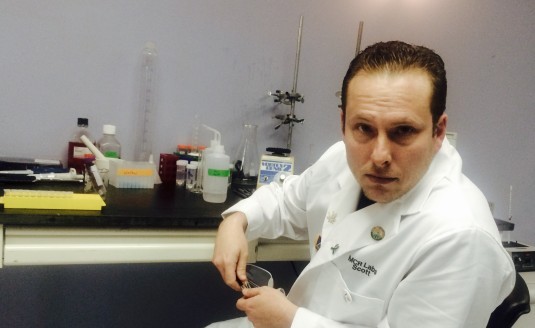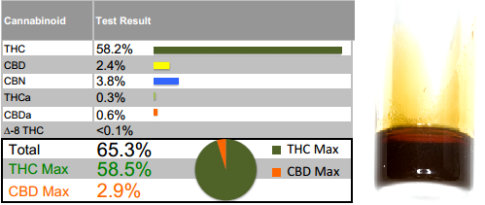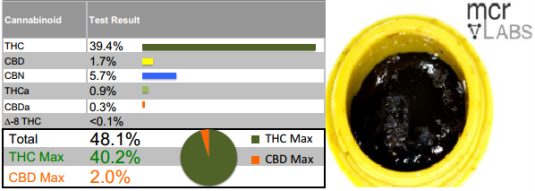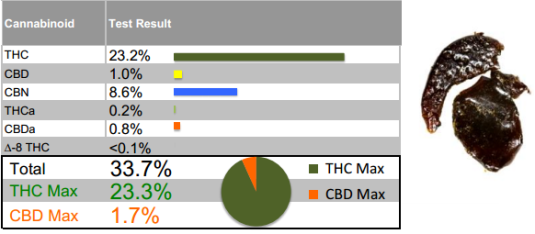We Tested Reclaim, and This is What We Found.
You asked what was in reclaim, so we tested it. Here's what we found.

Not too long ago, our illustrious Director of Scientific Operations Scott Churchill decided to see what was in the resin collecting in his pipe. His post seemed to generate a lot of interest, and we asked what you wanted us to test next. Many of you had requested we do an analysis on reclaim: the leftover, unvaporized/recondensed oil that collects in your rigs and dropdowns. So, we listened and set out to find what was in reclaim.

We tested four different samples of reclaim. Each sample was unique in the manner it was collected. They differed in smell, consistency, and color. All analysis was performed using HPLC-UV, in the exact same manner our typical cannabinoid profile is conducted.
The first sample of reclaim (reclaim 1) had been collected from a drop-down. It appeared to look like dark, amber colored honey or maple syrup. To be completely honest, it looked pretty appealing. There was very little particulate in the oil, and when held up to a light it was not opaque but translucent. It was highly viscous at room temp and sticky. Not surprisingly, the profile came back highly potent in cannabinoids. All of the five major cannabinoids we quantify for came up, with the majority being delta 9-THC. The Max THC of this sample was 58.5%, which equates to 585 mg’s of THC for every gram of reclaim. Additionally, there was a Max CBD of 2.9% and CBN measured at 3.8%. The total cannabinoid content was 65.3%, and 98.6% of those cannabinoids are activated.

The second sample (reclaim 2) came from my personal reclaim collection. Mainly, all of this oil had been collected by scraping the reclaim that had fallen down the direct inject of my rig, or from the inner coil of my Infiniti nail. It was contained in a No-Goo container, and was constantly added to over time. The color was completely black and opaque, and the consistency was that of tar you would find at the beach. It was not sticky at first touch, but becomes difficult to work with once heated. Again, all five cannabinoids were quantified with delta-9 THC being the highest. The Max THC was 40.2%, Max CBD was 2.0%, and CBN was 5.7%. As you can see, the THC and CBD is lower than the first sample, but CBN had increased. The total cannabinoid percentage was 48.1%, much lower than the first, and 97.3% of those cannabinoids are activated.

The third sample (reclaim 3), like the first, was collected from a dropdown. This reclaim had a similar consistency to the first, but had a much darker appearance. It was very sticky to the touch, and smelled slightly unpleasant. In a similar trend, all five cannabinoid were found, with delta-9 THC being the most prevalent. The Max THC was 50.3%, the Max CBD was 3.7%, and the CBN was 7.5%. The profile was similar to that of the first sample, albeit with lower THC and higher CBD and CBN. Total cannabinoids measured at 61.7%, and 98.9% of those were activated.

The final reclaim (reclaim 4) sample was very unique. It had been collected from a rig filled with so much reclaim you couldn’t even pull on it. In an attempt to salvage as much of the reclaim as possible while trying to avoid the use of isopropyl alcohol, I flashed the rig with my torch to lower the viscosity of the oil. I was able to get most to drip out the downstem, and collected it into a No-Goo. This sample then sat in the same non-stick container for over six months. When we decided to do this experiment, I thought this sample would be a good candidate. When I opened the container, the consistency was unlike all of the other samples. This sample of reclaim had turned back into a shatter like consistency, breaking and splintering when handled. It was completely black and stable at room temp, with no discernable odor. Max THC for this “shatterclaim” was only 23.3%, with the Max CBD at 1.7%, both on the low end across all tested samples. What was interesting was the extremely high amount of CBN, which was 8.6%. Out of the four samples, this one had the least amount of total measured cannabinoids, at 33.7% total. 97% of those cannabinoids were decarbed.

All four of these samples had increased levels of CBN, when compared to typical extracts and flowers. CBN, or cannabinol, is an oxidative breakdown product of THC, which is converted via heat/light/air/time. THCa will also convert into CBNa via similar mechanisms, but we cannot currently quantify for the acid form of CBN. CBN, along with THC, are the only known psychoactive phytocannabinoids, with CBN being classified as a weak psychoactive. Additionally, CBN is attributed to feelings of tiredness and/or drowsiness.
These tests show there are significant amounts of cannabinoids remaining in reclaim, in particular delta-9 THC. The question that remains is what is reclaims most effective use? Many, including myself not too long ago, would smoke it or use it to season their new titanium nails. Others have said they save it to cook into edibles. Some have said they simply throw it out, regarding it similarly to cigarette ashes. We cannot give any suggestions as to how to use your reclaim, but hopefully this data will help you make an informed decision.
